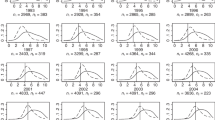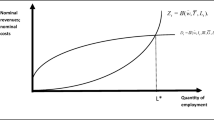Summary
A static limited dependent variable model is formulated to analyse the Dutch labour market from an individual's viewpoint. Results suggest that high minimum labour costs are an important source of unemployment. Secondly, the reduced-form participation equation is replaced by a neoclassical labour supply equation. Thus, also the effect of high minimum wage rates on employment through labour supply is taken into account. Supply appears to be forward bending and participation is insensitive with respect to unemployment benefits. Simulations suggest that the effect of lowering the ‘productivity threshold’ by reducing before-tax minimum wages dominates supply effects.
Similar content being viewed by others
References
Berndt, E., B. Hall, R. Hall and J. Hausman (1974), ‘Estimation and Inference in Nonlinear Structural Models,'Annals of Economic and Social Measurement, III/IV, pp. 653–665.
Brown, C., C. Gilroy and A. Kohen (1982), ‘The Effect of the Minimum Wage on Employment and Unemployment,’Journal of Economic Literature, XX, pp. 487–528.
CPB (1986),Centraal Economisch Plan, Central Planning Bureau, The Hague.
Frijns, J. and M. van Schaaijk (1987), ‘The Wage Distribution and the Structure of Employment in The Netherlands and the USA,’ Research paper 36, Central Planning Bureau, The Hague.
Hausman, J. and P. Ruud (1984), ‘Family Labor Supply with Taxes,’American Economic Review, LXXIV, pp. 242–248.
Johnson, N. and S. Kotz (1972),Distribution in Statistics; Continuous Multivariate Distributions, New York.
Kapteyn, A., P. Kooreman and A. van Soest (1988), ‘Quantity Rationing and Concavity in a Flexible Household Labor Supply Model,’ Working paper, Tilburg University.
Kapteyn, A. and I. Woittiez (1988), ‘Preference Interdependence and Habit Formation in Family Labor Supply,’ in: F. Laisney et al. (eds.),Contributions to Applied Microeconometrics, Clevedon, Avon, forthcoming.
Kooreman, P. and A. Kapteyn (1986), ‘Estimation of Rationed and Unrationed Household Labor Supply Equations using Flexible Functional Forms,’Economic Journal, XCVI, pp. 398–412.
Kuipers, S.K. (1984), ‘De ontwikkeling van de Nederlandse economic op middellange termijn in bet licht van bet gevoerde matigings- en bezuinigingsbeleid,’Maandschrift economie, XLVIII, pp. 437–453.
Meyer, R. and D. Wise (1983a), ‘The Effects of the Minimum Wage on the Employment and Earnings of Youth,’Journal of Labor Economics, I, pp. 66–100.
Meyer, R. and D. Wise (1983b), ‘Discontinuous Distributions and Missing Persons: The Minimum Wage and Unemployed Youth,’Econometrica, LI, pp. 1677–1698.
Schaaijk, M. van (1984), ‘Starre beloningsverhoudingen, starre werkloosheidsverhoudingen?,’ Research paper 1, Central Planning Bureau, The Hague.
Theeuwes, J. (1988), ‘Arbeid en belastingen,’ fromBelastingheffing en belastinghervorming, Koninklijke Vereniging voor Staathuishoudkunde, Leiden, pp. 111–143.
Tummers, M. and I. Woittiez (1988), ‘A Simultaneous Wage and Labour Supply Model with Hours Restrictions,’ Working paper, Tilburg University.
Van Soest, A., I. Woittiez and A. Kapteyn (1988), ‘Labour Supply, Income Taxes and Hours Restrictions in The Netherlands,’ Working paper, Tilburg University.
Author information
Authors and Affiliations
Additional information
The author wishes to thank Geert Joosten, Arie Kapteyn, Peter Kooreman, Bertrand Melenberg, Viji Narendranathan and Theo Nijman for helpful comments and the Netherlands Central Bureau of Statistics for providing the data. The views expressed in this paper do not necessarily reflect the policies of the CBS.
Rights and permissions
About this article
Cite this article
van Soest, A. Minimum wage rates and unemployment in The Netherlands. De Economist 137, 279–308 (1989). https://doi.org/10.1007/BF02115696
Issue Date:
DOI: https://doi.org/10.1007/BF02115696




